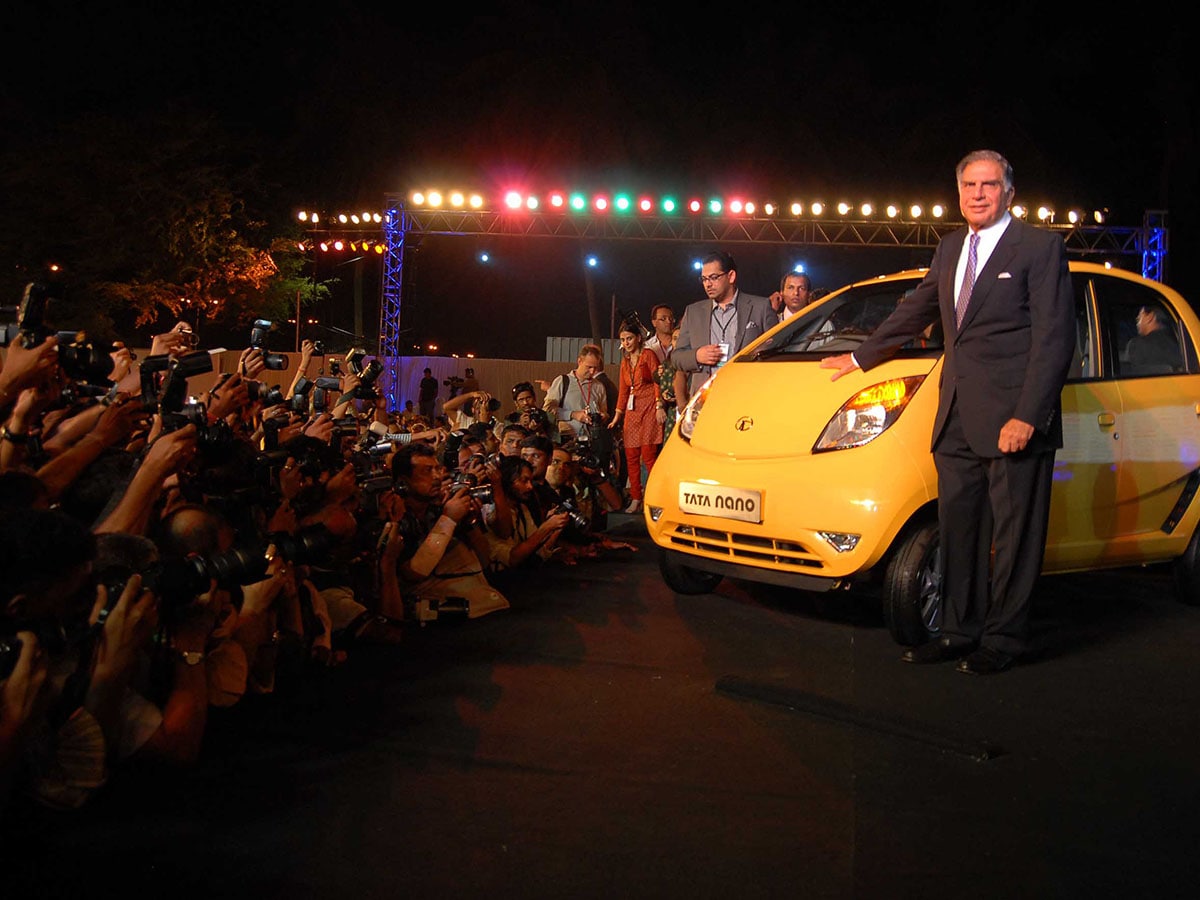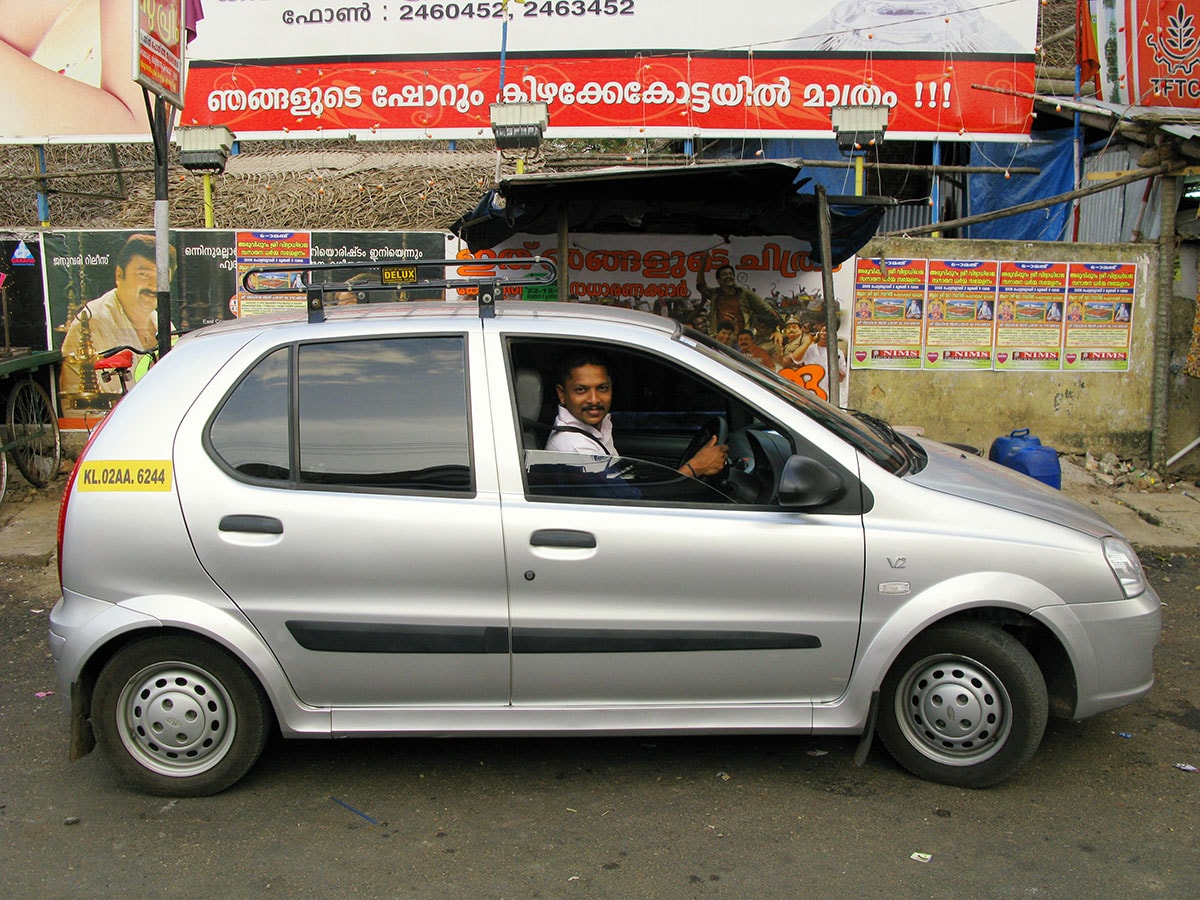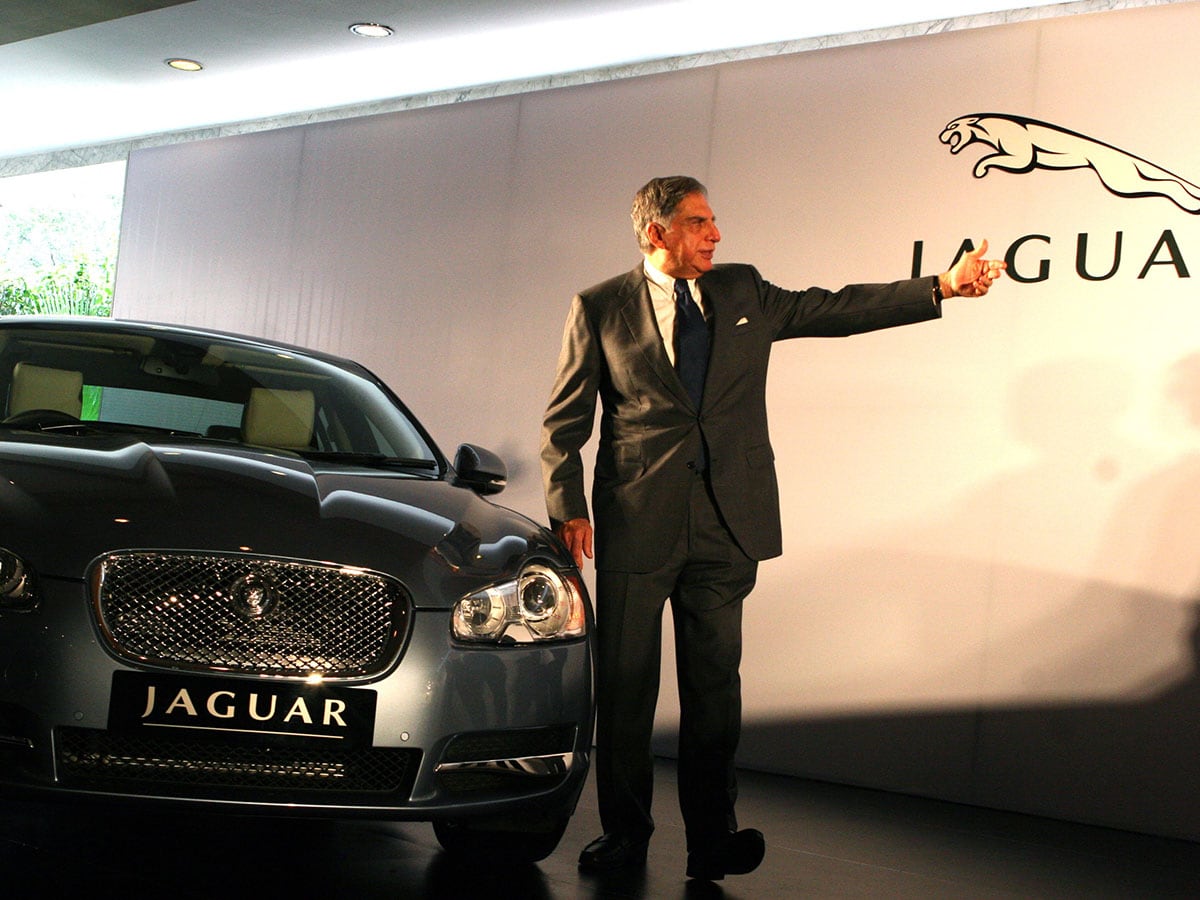
Ratan Tata, Chairman of Tata Motors and Tata Sons with Ravi Kanth, Managing Director of Tata Motors, posing with newly launched Tata Nano in Mumbai.
Image: Abhijit Bhatlekar/Mint via Getty Images
Very few individuals are lucky to be remembered for their personal contributions to building an automobile empire or a car, particularly in India.
As is often the case, successes in the auto industry are often a collective effort and notable exceptions to that in India’s automobile annals include that of Maruti Suzuki, for which the politician Sanjay Gandhi is oft remembered. But that’s mostly that in a country that sells a little over 4 million cars annually.
Except perhaps Ratan Tata.
Tata, the former chairman of Tata Group, who passed away on October 10, is often credited for personally pushing through two cars that set India’s automobile industry on a different tangent altogether, all while keeping the common man at the centre of it. While one of them would go on to become a resounding success and bestseller, the other, despite all the global attention and the might of the Tata group faltered, not before finding a special place in the country’s automobile history.
It all started with the Tata Indica, a hatchback, that came from the Tata Motors stables in 1998 and was among the first of the truly made-in-India products. It was a time when global automakers were making a beeline to enter India, which had just opened its economy after years of protectionism. Many would find local partners, and the lure of a global partner was even tempting for Tata Motors, which by then had made two successful cars after years of making commercial vehicles.
“Everyone told us it couldn’t be done without having a joint venture or a partnership with an international company,” Tata wrote on Instagram a few years ago. “That if I did this, I would be linked to failure. But we went ahead anyway. There were technical issues and many lessons we learned. It was a wonderful experience to be breaking new ground. The chances to give up were many. We stayed the course, worked out each issue, and that was the birth of India’s 1st indigenous car, The Tata Indica.”
In Tatalog, a book by Harish Bhat, the former brand custodian of Tata Sons, Ratan Tata detailed how he went about designing the Indica, “We decided to design a car with the internal volume of an Ambassador, the size of a Maruti Zen… We thought of pricing it close to the Maruti 800, and adding the economy of diesel,” Tata is quoted as saying in the book.
The Tata Indica would later go on to sell nearly a million cars and was even exported despite early setbacks. It was during such a phase that the Tata Group contemplated selling the automobile business to Ford when at a meeting, corporate folklore says that Tata was humiliated by the leadership at Ford, who questioned why the group was even dabbling in passenger vehicles.
Also read: The RNT Legacy: From radios to semiconductors, high technology was his buzzword
That prompted the group to relook at the shortcomings with the vehicle, before launching a second version of the vehicle. Upon its launch, the Indica V2 as it was called, became the fastest-selling automobile in Indian history when it completed sales of 100,000 cars in less than eighteen months. An economic slowdown in 2001 couldn’t play spoilsport, with Tata Motors recording a growth of 46 percent. The success of the car, also changed Tata Motors forever, giving it the necessary confidence to build a passenger vehicle business, that’s currently the third largest in the country, beating the likes of Volkswagen, Honda, and Toyota.
 Indian man with his new car model Indica produced by the indian car producer TATA on January 06, 2008 in Trivandrum, India.
Indian man with his new car model Indica produced by the indian car producer TATA on January 06, 2008 in Trivandrum, India.
Image: EyesWideOpen/Getty Images
But, despite that success with the Indica, and subsequently the Indigo, a sedan version of the Indica, Tata’s legacy often tends to be torn by the failure of the Nano, a project that he had personally rooted for, to push families on two-wheelers to a much safer option in a four-wheeler, all while making it affordable. The Tata Nano was touted as the world’s cheapest car at Rs 1 lakh.
“What really motivated me, and sparked a desire to produce such a vehicle, was constantly seeing Indian families on scooters, maybe the child sandwiched between the mother and father, riding to wherever they were going, often on slippery roads,” Tata said on Instagram last year. “One of the benefits of being in the School of Architecture, it had taught me to doodle when I was free. At first, we were trying to figure out how to make two-wheelers safer, the doodles became four wheels, no windows, no doors, just a basic dune buggy. But I finally decided it should be a car. The Nano was always meant for all our people.”
But, the Nano, was a colossal failure for the group, before it finally shut down production in 2008. In the first two years that the company sold the Nano, sales never moved past 70,000 units, and had also suffered from the negative perception of a cheap vehicle. It also didn’t help that the Nano was in the eye of the storm when the Tata Group sought to manufacture the vehicle in Singur in West Bengal, for which it was to set up a factory before becoming embroiled in a protest by farmers, forcing the company to shift its location.
Also read: Ratan Naval Tata: Legend Through The Years
Going global
Still, despite the setback with the Nano and the success with the Indica, Ratan Tata’s legacy in the Indian corporate annals will remain the acquisition of Jaguar Land Rover, a move that made the world sit up and notice the group and put India’s automobile industry on the world map.
The group bought out Jaguar Land Rover from Ford Motors for $2.3 billion, in what many refer to as sweet revenge, amidst a global financial crisis, and made it a cash cow for the group. Today, JLR has revenues of £28.99 billion with profits of £2.57 billion. But, more importantly, the acquisition also led to a greater partnership between the domestic arm and JLR, in co-developing new products that have propelled the automaker into the country’s third-largest automaker.
 Ratan Tata presents the JLR brands to the audience in Mumbai on June 28, 2009.
Ratan Tata presents the JLR brands to the audience in Mumbai on June 28, 2009.
Image: Bhaskar Paul/The India Today Group via Getty Images
Now, with India’s automobile industry undergoing massive transformation with the changes in powertrain options, Tata is only expected to reap better dividends from JLR’s own electrification journey and pushing through in the domestic market. Already the company corners some 65 percent of the electric vehicle sales in the country. Tata Motors is also developing Avinya, a new electric vehicle for the Indian market in partnership with JLR while also setting up a manufacturing facility in Tamil Nadu for JLR, at a cost of $1 billion.
“When we bought (JLR), my friends distanced themselves from me, by saying, ‘What are you going to do with this?’ Quite frankly, I didn’t know. And that refrain changed to ‘How stupid could you be to buy this?’” Tata said in 2019 at an event in Brussels. “At my first meeting with the workers at Coventry, they asked me what are you going to do with this? So, finally, I stood up and said, why don’t we do this? Why don’t we shoulder-to-shoulder recreate the image that these two brands had and reignite the power of those two brands? I did nothing more.”
Today, The Tata Group is an automotive powerhouse, drawing on partnerships from other group entities including Tata Power, Tata Chemicals, Tata Autocomp, Tata Consultancy Services (TCS), Tata Digital, Tata Elxsi, and Tata Motors Finance, all of which have seen tremendous leaps during Ratan Tata’s tenure as the group chairman. In his passing, India’s automotive industry has most certainly lost an icon and a doyen who kept the common man at the heart.
